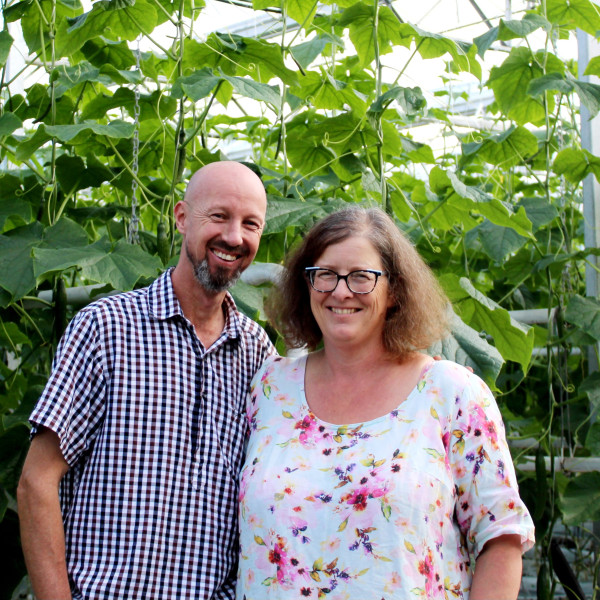Energy efficiency helps Waimakariri grower stay in business
13 June 2023
Rachael and Robert Lindsay have taken the first steps on their journey towards reducing energy use in their indoor cucumber operation in Canterbury. They are keen to share this information with other growers.
When the couple, along with Allen and Jo Lim, first bought into the 40-year-old business, Jade Garden Produce back in 2018, they came in with fresh eyes. They knew there would have to be significant changes.
“Having never grown a commercial indoor crop before, we had a lot to learn in a short space of time,” Robert says. “Every mistake was costly, and early on my understanding of the relationship between the plant, air temperature energy, and air moisture content was limited.”
With major operating costs rising every year – squeezing margins out of their cucumber harvest – the couple looked at what they could do to make changes. “If we were to remain growing, we had to be more efficient. Change is difficult but we had no choice,” Robert says.

Robert and Rachael Lindsay are co-owners of Jade Garden in Canterbury
They had to start somewhere, so employed the 80/20 rule which states that “80 percent of costs come from 20 percent of inputs. In our case, the 20 percent of inputs that had the biggest impact on operating costs were energy and labour. We decided to focus on energy first, starting with boiler efficiency, and then energy losses in the greenhouses after that,” Robert explains.
In 2019, with advice from their electrician, they built a do-it-yourself radiation sensor using a temperature sensor and a milk bottle painted black. They then linked the sensor to the boiler controller in order to reduce the boiler heating set-point when the sun was shining.
“As the milk bottle heats up it tells the boiler that the sun is providing a lot of heat to the greenhouses, so the energy input into the boiler can be reduced. When the sun is shining, the greenhouses do such a great job of capturing that energy that there is no need to heat them using our boiler – so why heat the water in the boiler to 90°C?”
The next step, reducing energy losses through the greenhouses, Rob tackled alongside Bert van Geffen, his horticulture coach.
“We focused on minimising energy loss, whilst still carefully watching greenhouse humidity levels. We have these wonderful energy screens that are automatically drawn over above the crop when the outside temperature gets low, in order save energy. Previously we had never fully closed our screens, because we needed to allow moist air to exit the crop and escape through the vents. However, we learned that our energy screens are permeable, allowing us to open vents above a fully closed screen – venting moisture but without losing as much warm air.”
The greenhouse environment is managed with a Priva climate computer. Basically, this opens hot water valves to heat the crops, and opens vents to cool the crops, and vent moist air. Changes to set-points result in visible changes in crop growth in as little as 24 hours.
Previously they used the basic climate settings, but with Bert’s advice and guidance, they are now exploring more advanced settings which has allowed the computer to manage the heating and venting in different scenarios.
“Say we get a nor’wester blowing, this drags too much moist air from the greenhouse, and stresses the plants. Using the advanced settings, Priva recognises the wind direction, and reduces the vent opening on the windward side, resulting in less moisture loss from the crop, and happier plants.”
Lastly, they focused on implementing some strategies found in the book Growing By Plant Empowerment (GPE) by Dutch authors Peter Geelen, Jan Voogt and Peter van Weel, which gave Robert insight into how much temperature drives the photosynthesis-respiration balance.
Linking the greenhouse temperatures to incoming sunlight meant they could control how much energy the plants were using. On sunny days they run warmer average temperatures than on cloudy days.
Energy is saved during the cloudy days because there is no point putting out a lot of heat when there is no sunlight to increase plant growth.
While it might mean slower growth than otherwise during the winter months, the plants look healthier when grown under this regime, and the cropping is more consistent.
The new technology has been a game changer. While Robert and Rachael did all of this to remain in business, there was obviously an environmental advantage as well.
In the first year after the solar sensor install, they made eight percent savings, in the second year 14 percent and the third year a huge 21 percent.
“I heard a great definition recently – to be a grower nowadays you need to be an agronomist, an engineer, a data scientist and a psychologist – all in one!” Robert says.
First published in the June 2023 issue of NZGrower magazine.
